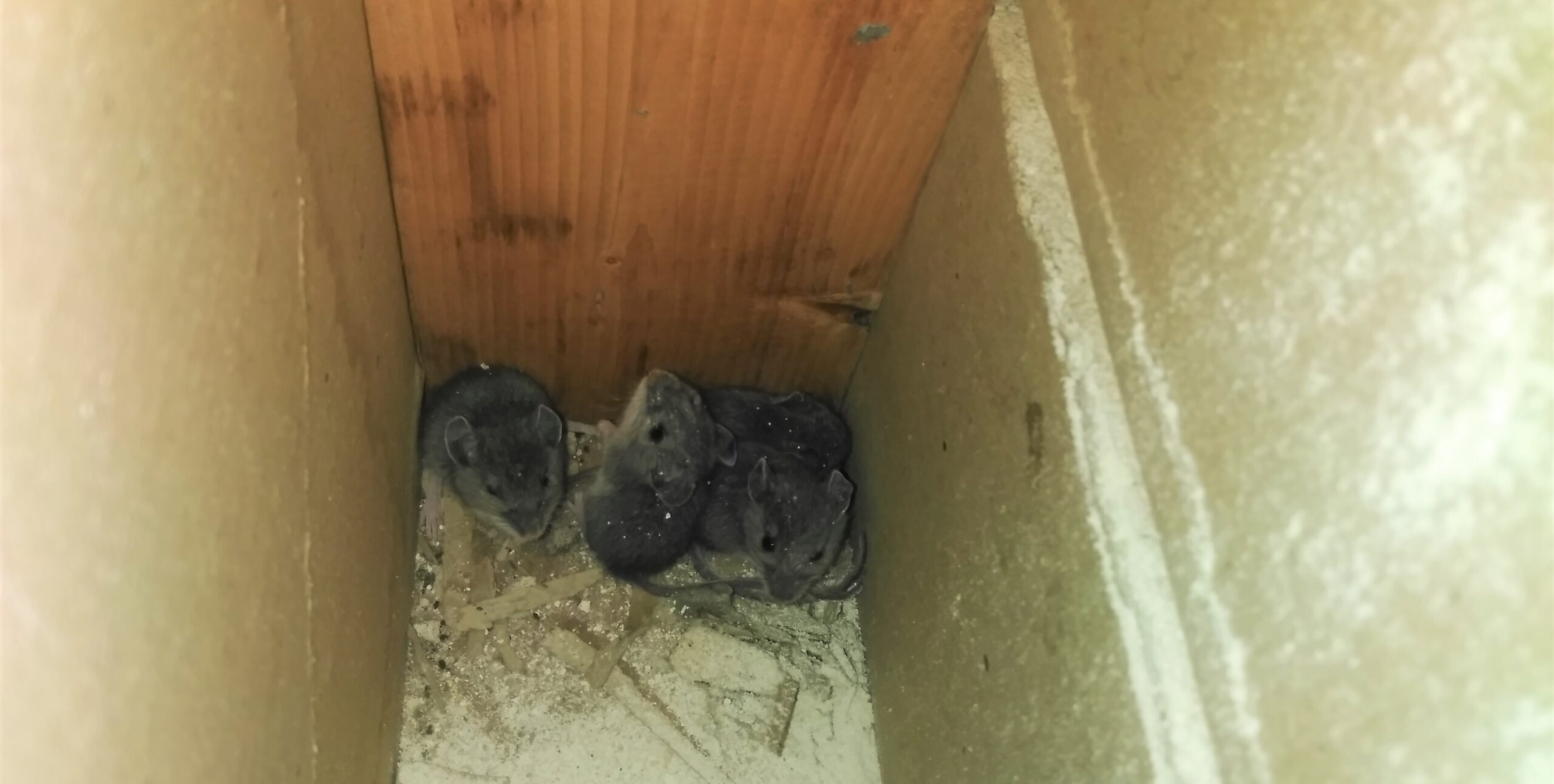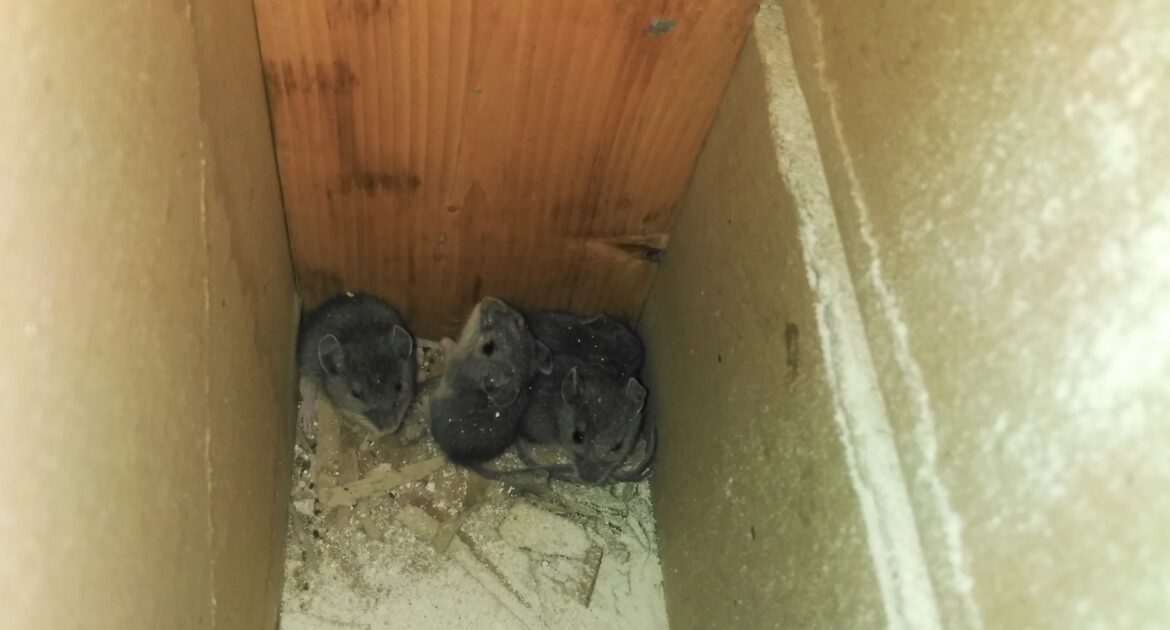Ever wonder how mice seem to appear out of nowhere, effortlessly dodging obstacles and finding food? It’s all thanks to their super senses! Mice are equipped with extraordinary sensory abilities that help them thrive in almost any environment.
From sharp hearing to an advanced sense of smell, these tiny animals are experts at making the most of their surroundings. For Toronto homeowners, this can become a problem when mice decide to make your home their home.
At Skedaddle Humane Wildlife Control, we understand how mice navigate and use their sensory abilities. When you have a mouse problem, Skedaddle’s humane, effective solutions—like our unique one-way doors—can help.
But before we talk about that, let’s explore exactly what makes mice so extraordinary. Here’s a closer look at mice’s super senses and how they manage to move through the world undetected.
The Power of Smell
Mice rely heavily on their sense of smell to interact with their environment. This is one of the strongest mouse sensory abilities, allowing them to perform tasks like finding food, identifying threats, and even communicating. A mouse’s nose isn’t just sensitive—it’s a critical survival tool.
But, how do mice use their sense of smell?
- Finding Food: Mice can detect food from far away. Breadcrumbs on your kitchen counter are like a flashing neon sign to them. That’s because their noses can pick up odours in parts per billion—an ability few animals can match.
- Recognizing Threats: Mice use smell to sense danger, such as predators or strong chemical odours. This helps them avoid risky areas.
- Communication: Did you know mice can leave scent trails? These trails, made from their urine, help them and other mice find their way back to normal routes or food sources. Scent markings also play a role in territory and mate selection.
Their incredible olfactory strength means DIY methods like scented repellents rarely work. Mice can easily work their way around the scent. If they’ve already invaded your home, calling in professionals like Skedaddle is the best way to effectively address the issue.
Exceptional Hearing Capabilities
Ever heard the phrase “quiet as a mouse”? While mice might be silent to you, their world is anything but quiet. Their hearing is another example of their super senses at work. Mice have an incredible range, able to hear frequencies up to 90,000 Hz—far beyond what humans can detect.
Why is hearing important for mice, really?
- Detecting Predators: Mice can pick up on high-pitched sounds like the rustling of a bird of prey or the soft steps of a cat.
- Communication: Mice use ultrasonic sounds to “talk” to each other. These squeaks are essential for social interactions, from warning others about danger to attracting mates.
- Navigating the Dark: Since mice are mostly nocturnal, they rely on their acute hearing to move safely at night. They can listen for faint sounds indicating obstacles or openings.
Their sensitive ears allow mice to survive in environments full of noise, movement, and potential dangers.
Whisker Magic
When it comes to touch, mice take it to another level with their whiskers. Officially called vibrissae, whiskers give mice the ability to “feel” their surroundings. This is how they navigate tight spaces, explore new areas, and avoid obstacles, even when it’s pitch dark.
So, how do whiskers work?
- Mice use whiskers to sense surfaces and textures by brushing them against objects.
- They can detect changes in air movement, helping them understand their surroundings.
- Whiskers give mice a sort of “map” of the area they’re exploring, so they can avoid danger or find pathways.
This tactile sense is crucial for mice, especially in urban environments like Toronto, where they have to dodge walls, pipes, and furniture to get around.
Limited but Useful Vision
Mice aren’t known for their eyesight, but that doesn’t mean they’re entirely in the dark. Their vision is limited and blurry, but it’s uniquely adapted for their lifestyle. For one, mice can see ultraviolet light, which helps them find urine trails left by other mice.
How does mouse vision actually contribute to survival?
- Low-Light Adaptation: Mice are able to see in dim environments, making them well-suited for nocturnal activities.
- Recognizing Patterns: They can detect contrasts and patterns within their limited range, helping them locate food or avoid predators.
- Ultraviolet Light Detection: This unique ability helps mice stay informed about their surroundings and find pathways marked by scent trails others have left behind.
Even though their eyesight isn’t perfect, mice prove that it’s not their primary tool for finding their way. Instead, their super senses of hearing, smell, and touch pick up the slack.
Navigation Skills That Amaze
One fascinating aspect of how mice navigate is their ability to create mental maps of their environment. They combine input from all their senses—smell, hearing, whisker touch, and even spatial memory—to move through their surroundings efficiently.
How do mice build these maps?
- They memorize safe routes based on repeated travel.
- Landmarks serve as visual or scent-based cues to help them find their way back to nests or food sources.
- Some experts believe mice can even detect magnetic fields, which may provide them with a unique form of direction.
This skill explains why mice can make their way around your home once they get inside. They quickly memorize floor plans and figure out the best hiding spots, food sources, and escape routes.
Why Mice Prefer Human Spaces
Mice are adaptable, which is why they thrive in urban and suburban environments. Your home offers everything they need—food, warmth, and shelter. With their sharp sensory abilities, they can find hidden cracks, sneak into tight spaces, and feast on the tiniest crumbs.
While their sensory powers are impressive, they can also make mice a significant nuisance when they gain access to your property. Blocking entry points and removing food sources are essential first steps in deterring them. However, when a full infestation occurs, it’s time to call in experts.
How Skedaddle Provides Humane and Effective Removal
At Skedaddle Humane Wildlife Control, we know how to handle mice using humane, innovative techniques. One of our most effective tools is our one-way doors, which allow mice to exit your home safely but prevent them from coming back. It’s a humane solution that prioritizes the well-being of the animals while protecting your home.
Our team thoroughly inspects your property to identify problem areas and uses permanent solutions that keep mice out for good. Rather than relying on DIY methods, which often fail, trust our experienced team to get the job done right the first time.
Here’s why you should choose Skedaddle:
- We focus on humane practices.
- Our one-way doors solve the problem without harming the mice.
- With over 30 years of experience, we understand how mice navigate and use that knowledge to protect your home.
Say Goodbye to Mice for Good!
Mice may be small, but their super senses make them formidable survivors. From their keen sense of smell to their whisker-powered navigation, they have all the tools they need to thrive. This is mice’s super senses at work. Unfortunately, this means they can also cause significant problems when they move into your home.
If you’re dealing with mice, don’t leave the problem to chance. Skedaddle Humane Wildlife Control in Toronto is here to help. Request an estimate today to learn more about our humane mouse removal strategies, including our one-way doors that keep them out for good. We’ll handle the problem, so you don’t have to.




